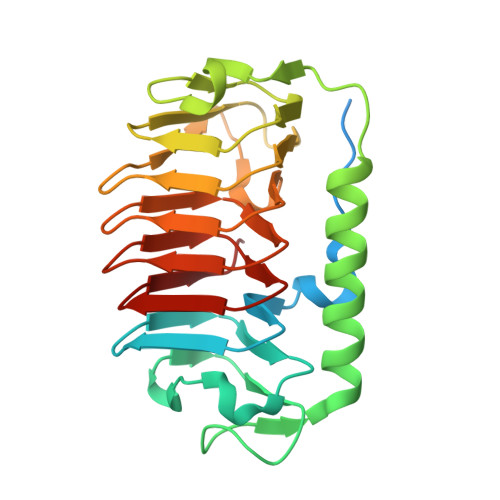Importance of rigidity of ice-binding protein (FfIBP) for hyperthermal hysteresis activity and microbial survival.
Hwang, J., Kim, B., Lee, M.J., Kim, E.J., Cho, S.M., Lee, S.G., Han, S.J., Kim, K., Lee, J.H., Do, H.(2022) Int J Biol Macromol 204: 485-499
- PubMed: 35149098
- DOI: https://doi.org/10.1016/j.ijbiomac.2022.02.032
- Primary Citation of Related Structures:
7EHK - PubMed Abstract:
Ice-binding proteins (IBPs) are well-characterized proteins responsible for the cold-adaptation mechanisms. Despite extensive structural and biological investigation of IBPs and antifreeze proteins, only a few studies have considered the relationship between protein stabilization and thermal hysteresis (TH) activity as well as the implication of hyperactivity. Here, we investigated the important role of the head capping region in stabilization and the hyper-TH activity of FfIBP using molecular dynamics simulation. Data comparison revealed that residues on the ice-binding site of the hyperactive FfIBP are immobilized, which could be correlated with TH activity. Further comparison analysis indicated the disulfide bond in the head region is mainly involved in protein stabilization and is crucial for hyper-TH activity. This finding could also be generalized to known hyperactive IBPs. Furthermore, in mimicking the physiological conditions, bacteria with membrane-anchored FfIBP formed brine pockets in a TH activity-dependent manner. Cells with a higher number of TH-active IBPs showed an increased number of brine pockets, which may be beneficial for short- and long-term survival in cold environments by reducing the salt concentration. The newly identified conditions for hyper-TH activity and their implications on bacterial survival provide insights into novel mechanistic aspects of cold adaptation in polar microorganisms.
Organizational Affiliation:
Research Unit of Cryogenic Novel Material, Korea Polar Research Institute, Incheon 21990, Republic of Korea; Department of Polar Sciences, University of Science and Technology, Incheon 21990, Republic of Korea.















